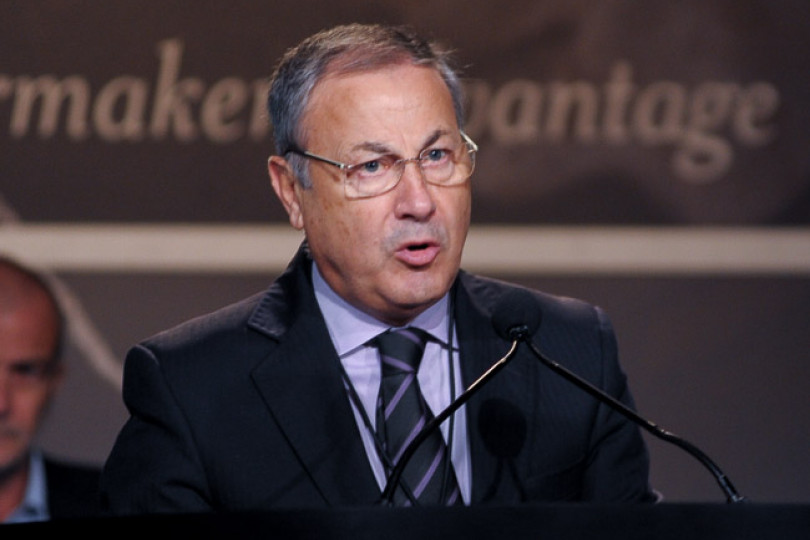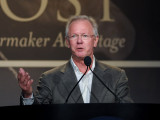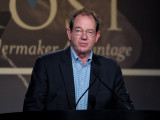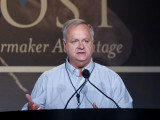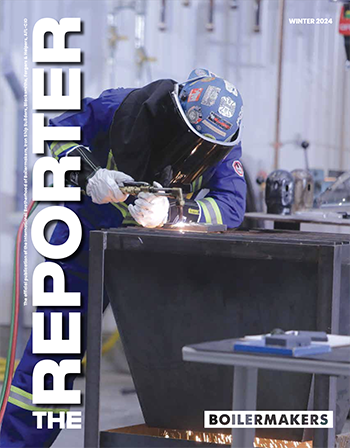Carlo De Masi, Italian Federation of Electrical Utility Workers
View Photo Gallery (5 photos)
Italian union delegation praises MOST
ABOUT 300 representatives of the National Tripartite Alliance met in Myrtle Beach, S.C. Oct. 15-18 to address industry issues affecting owners, contractors, and Boilermakers. It was the 27th national meeting of the alliance, which over the years has developed numerous innovations through the MOST trust.
MOST (Mobilization, Optimization, Stabilization, and Training) creates industry-leading programs designed to ensure that Boilermakers receive the best training available to the craft and offer the highest value to owners and contractors.
The conference welcomed a delegation from the Italian Federation of Electrical Utility Workers that was visiting the United States. Secretary-General Carlo De Masi praised the Tripartite Alliance and MOST. He said his union hopes to create a similar organization in Italy.
De Masi also called for increased cooperation among world unions to balance the power of multinational corporations.
During the four-day conference, participants heard from presenters on many topics, with an emphasis on EPA regulations affecting coal use. The EPA’s Gina McCarthy, Assistant Administrator for the Office of Air and Radiation, had been scheduled to present but cancelled shortly before the event, citing personal reasons.
Other key topics included the Phillips 66 Wood River refinery project, the MOST Boilermaker Delivery System, the referral system, the new MOST website, and work opportunities in Canada.
“Hyper-stringent” EPA rules cost jobs, raise rates, says IP Jones
INT’L. PRESIDENT NEWTON B. Jones expressed concern about the EPA’s current crop of fossil fuel regulations, calling them “hyper-stringent” and costly.
“With these federal dictates, we have witnessed the shutdown or planned shutdown of dozens of coal-fired power generation systems. And with those shutdowns went good-paying jobs, lower-cost energy, and millions of maintenance man-hours that our craft, among others, relies on.”
IP Jones added that although natural gas is currently the fuel of choice, it also is under attack. “Gas is the next fossil fuel to undergo the extreme opposition of environmentalists and ultimately of EPA regulators.”
“American coal is going to be burned in a dirtier state [in China] than it if it is burned in America.” — IP Newton B. Jones
He stressed that shutting down coal-fired plants in the United States would not have the impact on global carbon dioxide emissions and climate change that many believe.
“Instead of fueling American power generation systems, most of which have significant flue-gas scrubbing systems, we are exporting American coal to China to fire Chinese power generation systems” with far fewer environmental controls. “The reality is that American coal is going to be burned, and it’s going to be burned in a dirtier state [in China] than it if it is burned in America.
“In my view, these EPA regulations have hurt jobs; they have hurt employers; they have harmed our industries; they will ultimately cost consumers more for their energy needs — all without really helping reduce CO2 emissions in this world’s shared atmosphere.”
Bailey rejects anti-coal rhetoric
TWO LEADING VOICES in the coal industry – Paul Bailey and Gene Trisko – also spoke about industry and regulatory developments.
Bailey is the Senior Vice President for Federal Affairs and Policy with the American Coalition for Clean Coal Electricity (ACCCE). He took aim at anti-coal rhetoric by environmental groups and even the EPA. He charged that those who say clean coal and clean coal technology don’t exist ignore the fact that the industry has spent $110 billion over the last three decades and reduced emissions by 85 percent per kilowatt hour of electricity generated.
“For every $1,600 in cost you get $1 in benefits [from EPA’s MATS rule].” — Paul Bailey, ACCCE
“By 2016, 90 percent of coal-fired capacity will have advanced emission controls — selective catalytic reduction, wet scrubbers, dry scrubbers, dry sorbent injection — all clean coal technologies.”
The problem, Bailey added, is that coal opponents have construed the definition of clean coal to mean “just reducing carbon dioxide.”
Bailey said claims that the benefits from EPA regulations outweigh their costs are wrong. He noted that National Economic Research Associates estimates that four EPA regulations would result in net losses of 183,000 jobs per year, from 2012 to 2020. Moreover, the cost of complying with just one of the regulations — the Mercury and Air Toxics Standards or MATS — is estimated at $10 billion a year.
“This is the single most expensive rule that EPA has ever written for coal-fired power plants,” Bailey said. “Using EPA’s own numbers, the best thing you can say about the rule is that for every $1,600 in cost you get $1 in benefits. If you use the lower end of EPA’s health benefits, you get a cost-benefit ratio of 19,200 to 1 [$1 dollar of benefit for every $19,200 in cost].”
EPA’s preference for natural gas carries risks, says Trisko
GENE TRISKO, AN attorney for the United Mine Workers of America, said the government has shown a strong, and perhaps risky, preference for natural gas over coal.
“Natural gas from a policy perspective has now been elevated to be the only fossil fuel for base-load electric generation in this country. One has to evaluate the merits of that policy in light of the longer term prospects for the price of natural gas.”
Trisko said new construction for base-load generation must take into account a 40- to 60-year lifespan of the assets, but natural gas fuel prices are likely to rise, even in the short term.
“We must maintain solidarity . . . for those of us whose livelihoods depend on fossil energy.” — Gene Trisko, UMWA
“Competing uses of natural gas in transportation, petrochemicals, and the like . . . will tend to drive the price up.” Moreover, there is growing international demand. “The world price of LNG [liquefied natural gas] is not two or three or four dollars per million BTUs [as it is in the United States]; it’s $13 to $16.’
Although regulatory pressures continue to threaten the coal industry, Trisko said there has been some success in pushing back.
“In August, EPA granted [the Boilermakers’] petition for reconsideration of the mercury MATS standards for new sources. This followed a letter sent to President Obama from IP Jones on behalf of seven unions requesting that the president give favorable attention to the petition. Petitions were also filed by pollution control vendors and other interests, because the limits that were set could not be achieved by any coal plant.
“This is the kind of leadership we need. If we are to succeed [in amending EPA regulations] . . . we must maintain solidarity within the Union Movement for those of us whose livelihoods depend on fossil energy.”
Phillips 66 executive praises MOST programs
LARRY SICKING, PROJECT manager for the $3.8 billion Phillips 66 Wood River refinery expansion completed last December, told the conference that his project saw direct benefits from various MOST programs.
The three-year project included a new coker unit, new sulfur plant, new hydrogen plant, two wet gas scrubbers, and the replacement of a secondary distillation column. More than 300 Boilermakers from Local 363 (East St. Louis, Ill.) and sister locals from around the country took part in the expansion at peak manning.
“When folks come to us with [MOST training] already in place, it obviously makes our job a lot easier.” — Larry Sicking, Phillips 66
“I think obviously the MOST programs have been integral in the evolution of the Boilermaker trade and the safety performance and safety culture that you guys have created,” Sicking said. “When folks come to us with that already in place, it obviously makes our job a lot easier.”
In addition to OSHA safety training through MOST, Sicking cited steel erection, rigging, project management, project leadership, and other MOST programs as being beneficial to completing the refinery project.
